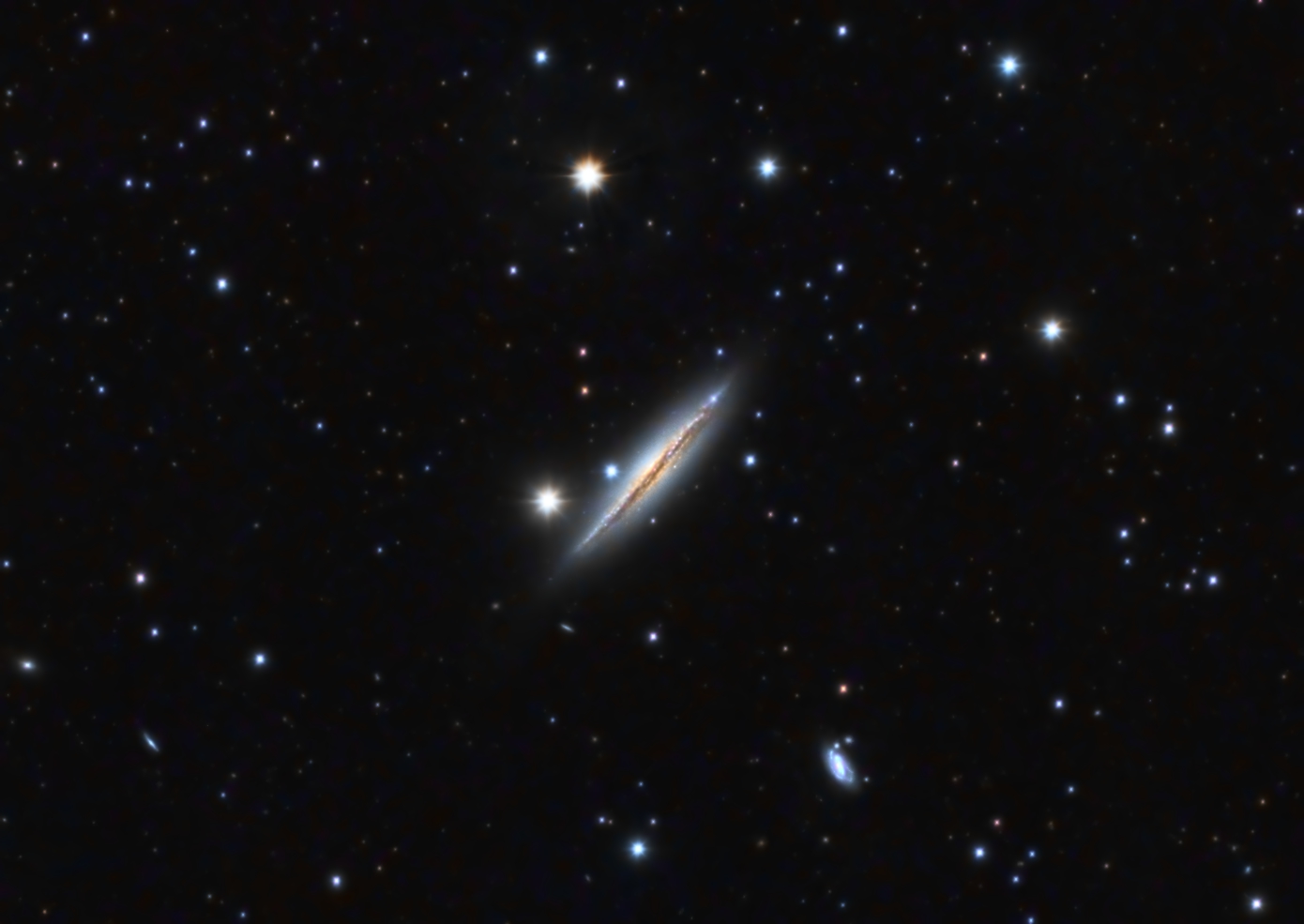NGC 4217

Click image for full size version
March 23, 2021
This image of NGC 4217 proves that it is most definitely galaxy season for deep-sky imaging! I came across this pretty little barred-spiral galaxy while imaging much larger M106. NGC 4217 tends to be overlooked as a small smudge in the field with M106, or cropped out of the frame altogether. NGC 4217 has a really interesting, twisted dark lane, and also shows some knots of star clusters and nebulae. It is located about 60 million light years away in Canes Venatici. Hubble shots show intricate structures in the dust filaments, but my little earth-based telescopes only begin to hint at them. There are a few other galaxies in this field. NGC 4226 is to lower right of centre. Much fainter PGC213956 is below the bottm tip of NGC 4217. Two more PGC galaxies are near the left side of the image; one looks like a splinter and the other like a fuzzy slightly elongated star.
Tekkies:
Acquisition, focusing, guiding and control of Paramount MX mount with TheSkyX. Focus with Optec DirectSync motor and controller. Automation with CCDCommander. Equipment control with PrimaLuce Labs Eagle 3 Pro computer. All pre-processing and processing in PixInsight. Acquired from my SkyShed in Guelph. Average or better transparency and seeing. Data acquired March 4-21, 2020 under a mainly moonless sky.
Luminance: Sky-Watcher Esprit 150 f/7 refractor and QHY 16200-A camera with Optolong UV/IR filter
Chrominance: Takahashi FSQ-106 ED IV @ f/5 and QHY367C Pro one-shot colour camera with Optolong UV/IR filter
Luminance: 64x10m = 10hr40m
Chrominance: 193x5m = 16hr05m
Total: 26hr45m
Data Reduction and Initial Processing
Preprocessing: The WeightedBatchPreProcessing script was used to create the Luminance master frames (from the mono camera) and Drizzle files (from the one-shot colour camera). DrizzleInegration with CFA Drizzle was used to integrate the OSC drizzle files with 2x scaling.
Registration of RGB to Luminance master: The RGB master was registered to the Luminance master using ImageRegistration.
Gradient Removal: DBE was applied to Luminance and RGB masters using Subtraction.
Colour
Colour Balancing: Colour of the RGB master was balanced with PhotometricColorCalibration.
Linear Noise Reduction: MultiscaleLinearTransform was used to reduce noise in the background areas, using an internal mask to protect bright structures. Layer settings for threshold, strength and iterations were as follows: Layer 1: 5.0 0.85, 1 iteration; Layer 2: 3.5 0.75, 1 iteration, Layer 3: 2.0, 0.5, 1 iteration.
Stretching: HistogramTransformation was applied to make a pleasing, bright image, with background set to an intensity of approximately 0.10.
Luminance
Deconvolution: A star mask was made from the Luminance master to use as a Local Deringing Support Image. A copy of the image was stretched to use as a range mask. Deconvolution was applied (100 iterations, regularized Richardson-Lucy, external PSF made using the PSFImage script; Global dark deringing = 0.02).
Linear Noise Reduction: MultiscaleLinearTransform was used to reduce noise in the background areas of the Luminance-filtered image, using an internal mask to protect bright stars. Layer settings for threshold, strength and iterations: Layer 1: 5.0 0.85, 2 iteration; Layer 2: 3.0, 0.75, 1 iteration; Layer 3: 1.5, 0.25, 1 iteration.
Stretching: HistogramTransformation was applied to make a pleasing, bright image, with background set to an intensity of approximately 0.10.
Combining Luminance and Colour Images
Creation of LRGB: The Luminance was applied to the RGB image using LRGBCombination with default settings.
Additional Processing
Nonlinear Noise Reduction: TGVDenoise was used in L*a*b* mode to reduce noise with a mask used to target the background areas and protect the stars and nebula (max. 1,000 iterations and convergence selected for both lightness and chrominance).
Contrast Enhancement: LocalHistogramEqualization was applied to the galaxy only with scales of of 50 (max contrast 1.5, strength 0.25, 1 iteration), followed by a scale of 150 (max contrast 1.5, strength 0.18, 1 iteration).
Sharpening: MultiscaleLinearTransform was used to sharpen Layers 2 and 3 with strengths of 0.3 and 0.08, respectively. A mask was used to select only bright features in the galaxy for sharpening.
Final Steps: Background, galaxy and star brightness, contrast, and colour saturation were adjusted in several iterations using CurvesTransformation with masks as required. ICCProfileTransformation (sRGB IEC61966-2.1; Relative Colorimetric with black point compensation) was applied prior to saving in jpg format.






Beautiful little group here as well, very nice detail in the dusty arms of NGC4217, beautifully coloured too.